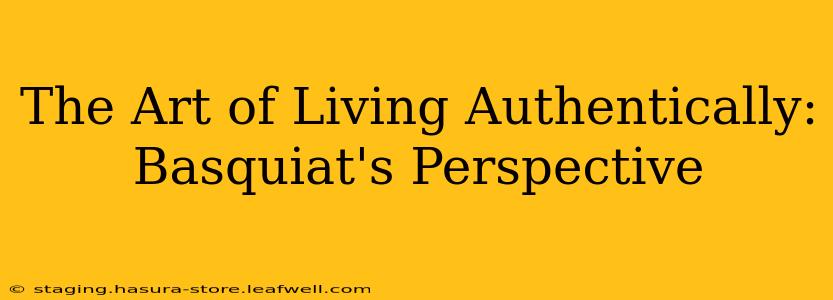Jean-Michel Basquiat, a name synonymous with raw emotion, explosive creativity, and unapologetic self-expression, offers a potent lens through which to examine the art of living authentically. His life, tragically short but intensely lived, serves as a powerful testament to embracing one's true self, despite societal pressures and internal struggles. This exploration delves into Basquiat's life and work to understand how he embodied authenticity and what we can learn from his journey.
What Made Jean-Michel Basquiat's Art So Authentic?
Basquiat's authenticity stemmed from his fearless embrace of his multifaceted identity. He was a Black artist navigating a predominantly white art world, a graffiti artist who transitioned to the high-art scene, a poet who expressed himself visually, and a complex individual grappling with fame, fortune, and personal demons. His art wasn't just aesthetically captivating; it was a visceral reflection of his lived experience, his anxieties, and his triumphs. He didn't shy away from depicting the harsh realities of racism, poverty, and social injustice, making his work deeply personal and undeniably authentic. His bold, raw style, often characterized by fragmented text, vibrant colors, and symbolic imagery, further amplified this sense of unfiltered self-expression. He refused to conform to artistic norms, forging his own path and leaving an indelible mark on the art world.
How Did Basquiat's Personal Life Reflect His Authentic Self?
Basquiat's personal life mirrored the unfiltered honesty of his art. He cultivated close friendships with fellow artists and musicians, forging connections based on shared creativity and mutual respect. He was known for his generous spirit, supporting fellow artists and engaging in collaborative projects. However, his life also reflected the internal battles he faced. His struggles with addiction and the pressures of fame are well-documented, illustrating the complexities of maintaining authenticity in the face of adversity. Even these struggles, however, became part of his narrative, influencing his artistic output and deepening the authenticity of his expression.
How Can We Apply Basquiat's Approach to Our Own Lives?
Basquiat's life and art offer valuable lessons for anyone seeking to live more authentically. His example encourages us to:
- Embrace our complexities: Basquiat didn't attempt to present a polished, idealized version of himself. He acknowledged and embraced the contradictions within him, translating those complexities into his art and his life.
- Challenge societal norms: He defied expectations and carved his own path, refusing to conform to the expectations of the art world. This inspires us to challenge societal norms and pursue our passions without fear of judgment.
- Find your unique voice: Basquiat developed a signature style that was distinctly his own. He didn't try to imitate others; he expressed himself authentically through his art. This encourages us to find our unique voice and express ourselves in ways that feel genuine.
- Embrace vulnerability: Basquiat's struggles with addiction and the pressures of fame are a reminder that vulnerability is part of the human experience. Embracing our vulnerabilities allows for genuine connection and self-acceptance.
Was Basquiat's Authenticity a Conscious Choice?
Whether Basquiat's authenticity was a conscious choice or an innate trait is debatable. It's likely a blend of both. His early experiences—growing up in a creative, multicultural environment, his exposure to the New York City art scene, and his personal struggles— undoubtedly shaped his worldview and artistic expression. However, his conscious decision to embrace his unique voice and relentlessly pursue his artistic vision is undeniable. His journey illustrates that authenticity can be both an inherent quality and a cultivated one.
What are the Challenges of Living Authentically in Today's Society?
Living authentically in today's society presents unique challenges. The pressure to conform to societal expectations, often amplified by social media, can make it difficult to express one's true self. The constant barrage of curated online personas can create a sense of inadequacy and pressure to present a perfect image. Overcoming these challenges requires self-awareness, courage, and a willingness to embrace vulnerability and reject the pursuit of superficial validation. Basquiat's life serves as a powerful reminder that true authenticity is far more rewarding than conforming to external pressures.
Conclusion
Jean-Michel Basquiat’s life and work stand as a powerful testament to the transformative power of living authentically. His fearless self-expression, his refusal to conform, and his embrace of his complexities offer invaluable lessons for navigating the complexities of modern life. By embracing our own multifaceted selves, challenging societal norms, and cultivating our unique voices, we can honor Basquiat's legacy and live lives that are both meaningful and true to ourselves.

